Commercial Bakeware Buyers' Guide
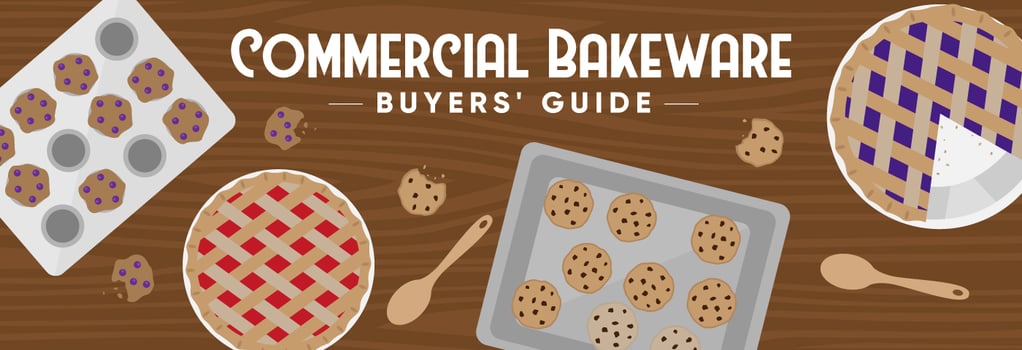
Baking often is thought of as a cooking method best suited for desserts, but bakeware and oven-safe cookware can be used to perfect a number of delicious entrees as well. For example, roasting pans and Dutch ovens are great tools for roasting meats and vegetables, and bread is a staple component in many restaurants.
What Type of Bakeware Do You Need?
There are several different types of commercial bakeware available: What you need for your kitchen depends on which items your menu offers. Below, we've created a guide to help you decide which bakeware belongs in your kitchen.
| Type | Description | Example |
| Sheet Pans | Sheet pans can be baking pans, which generally are designed with one or two raised edges, or bun pans, which also are known as jelly roll pans and have raised edges on all four sides. Both can be used to bake items that don't produce liquid, such as cookies and pastries, while bun pans can contain juices that foods release as they bake. Sheet pans commonly are half- or full-sized, but are available in smaller fractional sizes, too. | 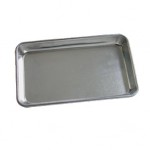 |
| Loaf Pans | Loaf pans can bake one or multiple loaves of traditional, French, or sub sandwich roll bread at a time, so you'll be able to find the right size pan for your commercial baking needs. Specialty bread pans, such as those used to bake brioche bread, are also available. | 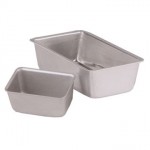 |
| Cake Pans | Cake pans, which are available in various sizes, can be round or rectangular, may be used for any basic cake, and can come in sets with multiple pans for businesses that make multilayered cakes. Tube cake pans are used for Gugelhupf and angel food cakes, while springform cake pans are used for cheesecake and other delicate cakes. | 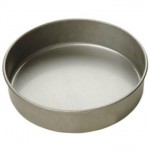 |
| Cupcake and Muffin Pans | Muffin pans commonly are used for muffins, cupcakes, cornbread, and popovers, as well as other breakfast pastries and baked treats. Muffin pans come in various sizes, equipping you to craft jumbo, standard, or miniature products. Some manufacturers also offer specialty pans for baking hot dog and hamburger buns. | 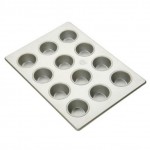 |
| Pie Pans | Pie pans are shallower than cake pans and designed with edges that taper out. They commonly are available in sizes ranging from 7 to 13 inches in diameter, but miniature pie pans can be as small as 4 inches in diameter. | 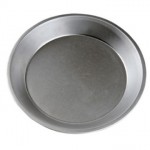 |
| Quiche and Tart Pans | Quiche pans feature a removable bottom, which enables you to remove the dish without damaging the delicate crust of the food. The diameter of a quiche or tart pan can range from 4 to 12 inches, so you can find the right size pan for your restaurant. | 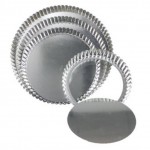 |
| Ramekins and Souffle Dishes | While the smallest ramekins are used as sauce cups, larger ones made from oven-safe materials can be used to bake single-serving entrees and desserts. Although souffle dishes – generally larger than ramekins – are made specifically for baking that dessert, ramekins can be used for that purpose, too. | 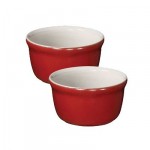 |
| Baking Dishes | Baking dishes are ideal for creating items like au gratin, casseroles, baked pasta, and other entrees. Many baking dishes are designed beautifully and retain heat to keep the dish warm – ideal for oven-to-table service. | 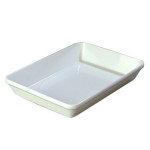 |
| Braising Pots and Dutch Ovens | Braising pots and Dutch ovens are popular types of oven-safe cookware, designed to slow-cook food, whether it's meat and vegetables or a casserole. Dutch ovens are deeper, which makes them ideal for stews, while braising pots are better suited to dishes with less liquid. These can be crafted from brightly colored enameled cast iron and are often used as serving dishes. | 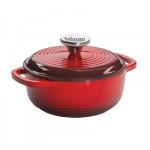 |
| Roasting Pans | Roasting pans, often available with a lid, are another popular type of oven-safe cookware that can double as a serving dish. Available in numerous sizes and shapes, they can be used to cook meat, vegetables, and casseroles, but are shallower than braising pots or Dutch ovens and are more compatible with dishes that don't require a liquid base. | 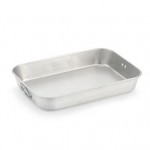 |
Which Material Do You Want?
Knowing what material your bakeware is made from is just as important as knowing what type of bakeware to use. Each material has its own advantages and disadvantages, and what material your commercial bakeware is crafted from can impact your cooking methods and quality of the end result. Aluminum, stainless steel, and cast iron are three of the most popular materials used in bakeware, but copper, ceramic, and glass are also common materials.
- Aluminum conducts heat well and usually is lighter in weight and less expensive than other materials. However, uncoated or non-anodized aluminum does react to acidic and alkaline foods, which may harm the flavor of a finished product.
- Stainless steel is a more durable material and doesn't transfer flavors to your products but is more expensive and may have trouble providing even heating. It does not conduct heat as well, so pieces made with this material often have a built-in layer of aluminum or copper to facilitate thermal transfer.
- Cast iron is heavier than other materials and takes longer to heat up, but it heats contents evenly. As an added bonus, seasoned cast iron is naturally nonstick. Because this material retains heat so well, it is a popular option for oven-to-table serveware for impressive displays.
- Copper is more expensive but has superb thermal conductivity and heats food evenly. Although this material reacts with acidic foods, most pieces have a lining made from a different metal to avoid this problem.
- Ceramic and glass are both heavy and may break if dropped, but they're also naturally nonreactive to acidic or alkaline foods. Although ceramic retains heat for a longer time, glass is less expensive.

